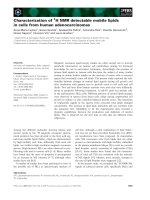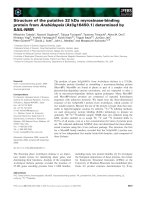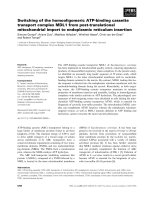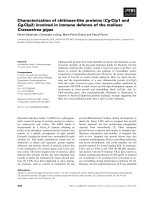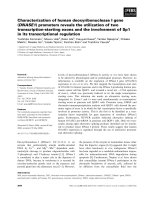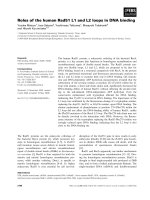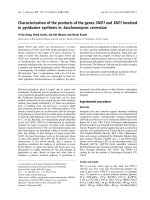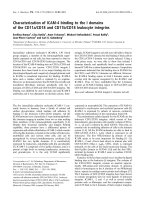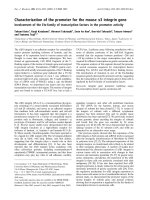Báo cáo khoa học: Characterization of HbpR binding by site-directed mutagenesis of its DNA-binding site and by deletion of the effector domain pot
Bạn đang xem bản rút gọn của tài liệu. Xem và tải ngay bản đầy đủ của tài liệu tại đây (842.97 KB, 11 trang )
Characterization of HbpR binding by site-directed
mutagenesis of its DNA-binding site and by deletion
of the effector domain
David Tropel
1
* and Jan R. van der Meer
1,2
1 Process of Environmental Microbiology and Molecular Ecotoxicology, Swiss Federal Institute for Environmental Science and Technology
(EAWAG), Du
¨
bendorf, Switzerland
2 Department of Fundamental Microbiology, University of Lausanne, Switzerland
The metabolism of 2-hydroxybiphenyl (2-HBP) in
Pseudomonas azelaica HBP1 is initiated by enzymes
encoded by the hbpCAD genes [1–4]. The main regula-
tor for hbpCAD expression is the HbpR protein,
which, upon exposure to 2-HBP, activates transcrip-
tion from promoters located upstream of hbpC (P
hbpC
)
and hbpD (P
hbpD
) (Fig. 1A) [4,5]. HbpR is a member
of the r54-dependent family of enhancer binding
regulators (EBR), more specifically related to XylR
and DmpR, regulators of xylene and phenol metabo-
lism in P. putida, respectively [4,6,7]. EBRs control
isomerization of the closed complex between r54-
RNA polymerase holoenzyme (RNAP) and the pro-
moter DNA, to the open form [8–11]. Isomerization
requires ATP hydrolysis by the regulator, an activity
that localizes in its strongly conserved central
Keywords
Pseudomonas azelaica; r54-dependent
transcriptional activators; XylR family
Correspondence
J. R. van der Meer, Department of
Fundamental Microbiology, Batiment de
Biologie, University of Lausanne, CH 1015
Lausanne, Switzerland
Fax: +41 21 6925605
Tel: +41 21 6925630
E-mail:
*Present address
M. E. Mu
¨
ller Institut-Biozentrum,
Klingelbergstrasse 70, CH-4056 Basel,
Switzerland
(Received 25 November 2004, revised 27
January 2005, accepted 10 February 2005)
doi:10.1111/j.1742-4658.2005.04607.x
In the presence of 2-hydroxybiphenyl, the enhancer binding protein, HbpR,
activates the r54-dependent P
hbpC
promoter and controls the initial steps
of 2-hydroxybiphenyl degradation in Pseudomonas azelaica. In the activa-
tion process, an oligomeric HbpR complex of unknown subunit composi-
tion binds to an operator region containing two imperfect palindromic
sequences. Here, the HbpR–DNA binding interactions were investigated
by site-directed mutagenesis of the operator region and by DNA-binding
assays using purified HbpR. Mutations that disrupted the twofold sym-
metry in the palindromes did not affect the binding affinity of HbpR, but
various mutations along a 60 bp region, and also outside the direct palin-
dromic sequences, decreased the binding affinity. Footprints of HbpR on
mutant operator fragments showed that a partial loss of binding contacts
occurs, suggesting that the binding of one HbpR ‘protomer’ in the oligo-
meric complex is impaired whilst leaving the other contacts intact. An
HbpR variant, devoid of its N-terminal sensing A-domain, was unable to
activate transcription from the hbpC promoter while maintaining protec-
tion of the operator DNA in footprints. Wild-type HbpR was unable to
activate transcription from the hbpC promoter when DA-HbpR was
expressed in the same cell, suggesting the formation of (repressing) hetero-
oligomers. This model implies that HbpR can self-associate on its operator
DNA without effector recognition or ATP binding. Furthermore, our find-
ings suggest that the N-terminal sensing domain of HbpR is needed to acti-
vate the central ATPase domain rather than to repress a constitutively
active C domain, as is the case for the related regulatory protein XylR.
Abbreviations
2-HBP, 2-hydroxybiphenyl; CBP, calmodulin-binding protein; EBR, enhancer binding regulator; EMSA, electrophoretic mobility shift assay;
RNAP, RNA polymerase holoenzyme; UAS, upstream activating sequence.
1756 FEBS Journal 272 (2005) 1756–1766 ª 2005 FEBS
(or C) domain [7,12,13]. The ATPase activity of the
C-domain is repressed by the regulator’s N-terminal or
A-domain, but released in response to a specific signal
[6]. For regulators such as XylR, DmpR and HbpR,
the signal is a chemical compound interacting directly
with the A-domain [4,14,15]. The complete signal-
ling ⁄ derepression ⁄ activation pathway seems paralleled
by cyclical changes in protomer configuration and the
EBR–RNAP–DNA complex. The regulatory protein
apparently cycles between dimers in solution and oli-
gomers on the DNA [16]. Crystallization data of an
NtrC1 single C-domain variant clearly showed a ring-
shaped heptameric configuration [17], but hexameric
structures have also been observed [18].
Like all EBRs, HbpR exerts its control by binding
to a specific operator sequence upstream of the promo-
ter [19]. The operator sequence for EBRs is usually
named the ‘upstream activating sequence’ (UAS) and
is characterized by two imperfect palindromes of 16 bp
and a spacing of between 29 and 42 bp between their
centres (Fig. 1A) [20]. The regions covered by XylR on
the P
u
and of HbpR on the P
hbpC
promoter in DNaseI
footprinting experiments were slightly larger than the
sequences of the palindromes [19,21], but the exact
contribution of nucleotides in the binding site contac-
ted by the proteins is not known.
The current hypothesis of hexameric EBR oligo-
mers on their operator DNA is not congruent with
the idea regarding the configuration of the binding
site. A binding site of two palindromes suggests that
the regulator’s configuration would be formed by two
dimers, a tetramer or any larger-order structure in
which not all subunits contact the DNA. Strangely
enough, the distance between the two palindromes can
be increased by one helical turn, but not by half a
turn, without losing activation and binding affinity
[19–22]. In DNaseI footprinting analysis of HbpR on
the hbpC operator, six distinct protected regions are
visible [19] (Fig. 1A), which would fit a hexameric
EBR symmetry in which each protomer contacts the
DNA.
The objectives of this work were to identify critical
motifs in the binding site for HbpR and to examine
the necessity of the sensing A-domain of HbpR for
DNA binding. The role of individual nucleotides and
nucleotide motifs was characterized by site-directed
mutagenesis and affinity binding by purified HbpR. In
several cases, DNaseI footprints were conducted to
confirm the binding site contacts. Additionally, we
determined whether the A-domain of HbpR is import-
ant in forming the oligomeric structure and for DNA
binding, by cloning an hbpR gene devoid of the
A-domain, purifying this protein, and analyzing its
DNA-binding characteristics and its activation capa-
city of the hbpC promoter in Escherichia coli.
Results
Mutagenesis of the HbpR-binding sites
Sequence alignment of the UASs found in the HbpR
operators in the hbpC and hbpD promoters defined
a set of strictly conserved nucleotides: GnnTTnAnn
AnnTnnTnA (Fig. 1B). When only the proximal or the
distal UASs were compared, additional conserved
nucleotides were found, which differed slightly between
the proximal and the distal sites. Some were located
A
B
Fig. 1. (A) Genetic organization of the hbp genes in Pseudomonas
azelaica strain HBP1. Open and grey bars (some as arrows) depict
the orientation and the size of the genes; the solid line indicates
noncoding DNA. The two HbpR-regulatable promoters are indicated
schematically with a small triangle and a ‘plus’; the location of the
different upstream activation sites (UASs) (C-4 ⁄ C-3, C-2 ⁄ C-1 and D-
2 ⁄ D-1) is indicated by small black pillars. HbpR is depicted schemati-
cally as a hexamer. Enlarged is the operator region bound by HbpR
within the hbpC promoter. The arrows within the sequence point to
two imperfect palindromic sequences (UASs C-1 and C-2). The grey
boxes (R11, etc.) indicate the regions protected in DNaseI footprints
by HbpR [19] and are used as such also in other figures. Sequence
numbers refer to the locations of the transcriptional start site of
hbpC. (B) Alignments of the sequences of three HbpR-binding sites
within the hbp gene region [19]. The lane ‘cons-1’ indicates the
strictly conserved residues in the proximal UASs, ‘cons-2’ indicates
those in the distal UASs, and ‘cons1+2’ indicates residues con-
served in all six UASs.
D. Tropel and J. R. van der Meer HbpR-binding site
FEBS Journal 272 (2005) 1756–1766 ª 2005 FEBS 1757
outside the UASs (Fig. 1A). Five of the distally and
seven of the proximally conserved nucleotides also
occurred in palindromes in the XylR, DmpR, and
TouR promoters (Fig. 2). Instead of separately muta-
ting every single nucleotide in the binding sites, it was
decided to construct group-wise mutations with the
idea that this would destabilize symmetrical structures
more easily. Some of these groups were based on
sequence motifs occurring in the P
u
promoter (e.g.
mutants 1–7, Fig. 2). All mutant binding sites were
then tested for affinity binding in electrophoretic
mobility shift assays (EMSAs) with increasing concen-
trations of calmodulin binding protein (CBP)–HbpR
(or His6–HbpR) (Fig. 3A) (0–1200 nm), upon which
the concentration at which 50% binding occurred was
interpolated (Fig. 3B).
A first set of mutations consisted of changing the
conserved ‘T’ and ‘A’ residues in the distal UAS
(Fig. 2). Mutants 12 and 15, with two mutations,
could still be bound by HbpR but with about twofold
less affinity, as determined by EMSA (Fig. 2). More
severely, HbpR lost about fourfold binding affinity
for mutants 13 and 14, with four and six conserved
residues mutated. This suggests that the conserved
residues indeed played an important role in contacting
HbpR at critical positions. That the rigidity of the
binding region was not influenced by the change from
four AT to four or six GC, was shown by mutants 8
and 9 (each with 3· GC and five mutations). Both
mutants 8 and 9 were bound equally well by HbpR
under the conditions of EMSA. Changing, more or
less randomly, other sets of bp (mutants 10, 11 and
16) did not influence the capacity to be bound by
HbpR. Strangely enough, however, mutations in resi-
dues, other than the conserved residues, resulted in the
same loss of binding affinity as observed for mutants
12, 13 and 15. Gradually changing the distal UAS to
the sequence of the P
u
promoter (mutants 1–4) very
quickly resulted in a loss of HbpR-binding affinity,
which culminated in a fourfold loss of binding affinity
in mutant 4. The fourfold loss of binding affinity did
not translate to a fourfold decrease of HbpR-mediated
expression of the luxAB reporter genes from the hbpC
promoter with the same type 4 mutation in E. coli [23].
In fact, the mutant 4 promoter still allowed activation
to about 72% of the maximum level observed for the
wild-type promoter (Fig. 2). Furthermore, mutations
in the proximal binding site, which did not per se
Fig. 2. DNA sequence of the different mutants and the HbpR concentration required for 50% binding in electrophoretic mobility shift assays
[expressed as n
M calmodulin-binding protein (CBP)–HbpR fusion protein]. Conserved residues in the proximal or in the distal upstream activa-
tion sites (UAS) are in bold (line ‘cons’, from Fig. 1). The residues conserved among DmpR-, HbpR-, TouR- and XylR-binding sites are depic-
ted by an asterix above the top sequence. Only the mutated nucleotides are presented (for the upper strand), with the appropriate mutant
names indicated on the right. Arrows point at palindromic symmetry in the distal UASs. Strictly conserved residues in both proximal and
distal UASs (‘cons1+2’, Fig. 1) are repeated at the bottom. The maximum relative induction level of HbpR-mediated luciferase expression in
Escherichia coli from the mutant promoters compared to the wild-type promoter was calculated on the basis of previous results [23].
HbpR-binding site D. Tropel and J. R. van der Meer
1758 FEBS Journal 272 (2005) 1756–1766 ª 2005 FEBS
influence the conserved residues, changed the binding
affinity for HbpR (mutants 5–7, Fig. 2).
Mutants 3, 8, 9 and 11 disrupted the twofold sym-
metry in the distal UAS, but without direct effect on
binding affinity. Mutant 1 was designed to maintain
twofold symmetry, yet binding affinity was reduced
twofold. Finally, mutant 17 contained a set of four
subsequent mutations, but outside the palindromes.
Still, binding affinity was reduced more than twofold.
Combining mutations in the distal and the proximal
site very drastically reduced the binding affinity by
HbpR and also by HbpR-mediated luciferase expres-
sion in E. coli (mutants 72, 45, 46 and 47, Fig. 2).
DNaseI footprinting analysis
In order to reveal whether the differences in binding
affinity were caused by changes in interaction patterns,
DNaseI footprinting of CBP–HbpR was performed on
mutant operator types 2, 4, 5, 7, 72 and 45 (Fig. 4).
Interestingly, this showed that a loss of binding affinity
correlated to a deterioration of binding contacts in
only those regions with new mutations, not throughout
the whole operator region. For example, HbpR bind-
ing to the mutant 4 operator behaved like the wild-
type operator as far as the UAS C-1 region was
concerned (Fig. 4). Binding to the UAS C-2 region (in
which the mutations had been placed), was impaired
both at the 3¢ end of the central regions R22 and R23,
whereas the region R21 and the 5¢ part of R22 were
again protected, as for the wild-type region. This sug-
gested a weaker interaction within this particular
region, but retainment of the overall binding complex
(although with weaker affinity, Fig. 2). In contrast, the
DNaseI footprint left by HbpR on the mutant type 5
operator showed normal protection of UAS C-2, but
almost no protection of the R13 region and the 3¢ end
of R12 in UAS C-1 (Fig. 4). The region R11 was again
normally protected, showing that the mutated bp in
operator type 5 must have affected the binding of one
particular set of contacts only, although still allowing
overall binding. The combination of mutation types 4
and 5 (operator type 45), on the other hand, not only
totally abolished the binding affinity (Fig. 2), but resul-
ted in almost no protection on any of the binding
regions, except at very high HbpR concentrations
(1000 nm). Similarly, mutant operators 2, 7 and 72
were analyzed for DNaseI footprints left by HbpR
(Fig. 4). As far as could be determined, the protection
pattern of HbpR on mutant type 2 was not affected,
except that protection of the UAS C-2 region occurred
at a higher HbpR concentration than for mutant type
7. Mutant type 7, like mutant 5, was impaired in bind-
ing of the R13 region. Both of these patterns contribu-
ted to the loss of binding contacts of mutant 72.
Construction of a DA HbpR derivative
In order to study whether the A-domain was import-
ant for DNA binding, several HbpR derivatives
(devoid of parts of their A-domain) were constructed.
One of these, the DA-HbpR variant (in plasmid
A
B
Fig. 3. Examples of several electrophoretic mobility shift assays
(EMSAs) with mutated operator fragments and calmodulin-binding
protein (CBP)–HbpR, and representation of the calculation of the
half-binding concentration. (A) EMSAs performed with DNA frag-
ments containing the wild-type upstream activation sites (UASs)
C-1 ⁄ C-2 (WT) sequence, or different mutants (as indicated at the
top of each panel), in the presence of increasing concentrations of
HbpR fusion protein (0–1200 n
M). Assignment of the UAS mutant
names corresponds to those given in Fig. 2. (B) Graphical represen-
tation of the relative densities of the free DNA measured at
increasing concentrations of HbpR. The percentage of free DNA
was calculated from densitometric measurements of the radiolabe-
led bands as the density of the remaining unbound operator frag-
ment at any HbpR concentration divided by that without HbpR (first
lane of each panel). The dashed arrow points to the graphical inter-
polation used to determine the concentration at which 50% binding
occurred. A summary of all values is presented in Fig. 2.
D. Tropel and J. R. van der Meer HbpR-binding site
FEBS Journal 272 (2005) 1756–1766 ª 2005 FEBS 1759
pHB171), was created by starting the hbpR reading
frame in the Q-linker, but adding a short affinity tag
at the new N terminus to facilitate recovery of the pro-
tein from cell lysates after overproduction. The tag
chosen was again the CBP, which had already been
used for purification of HbpR itself and has been
shown previously not to disturb HbpR-mediated tran-
scription activation [19]. SDS ⁄ PAGE of the soluble cell
extracts of E. coli BL21 (pHB171) showed a protein of
43 kDa (gel not shown), which corresponds to the
molecular mass of DA-HbpR (39 kDa) plus that of
CBP (4 kDa). This protein band was not detected in
extracts of E. coli BL21 (pCAL-n-). We concluded that
the fusion protein was correctly expressed in E. coli.
DNA-binding characteristics of the DA-HbpR
protein
EMSA performed on the wild-type HbpR-binding site
and increasing amounts of DA-HbpR or HbpR in
fusion with CBP showed that whereas 200 nm HbpR
was sufficient to bind all the operator DNA (Fig. 5A),
even 1200 nm DA-HbpR bound hardly any operator
DNA. No proteinÆDNA complex was observed (as for
HbpR), although a small fraction of the labelled DNA
remained in the well at higher concentrations of
DA-HbpR. On DNaseI footprint analysis, however, a
progressive protection was seen, of the six regions
identified previously (R11–R23), with increasing
amounts of both HbpR and D A-HbpR (Fig. 5B). The
protection pattern of the two proteins proved that the
derivative devoid of the A-domain still correctly inter-
acted with the six regions, although protection at R11
and R12 took place at higher DA-HbpR concentra-
tions than for HbpR. Hence, removing the A-domain
of HbpR did not impair regulator interactions with the
operator DNA per se, but affected the protein–DNA
complex stability in EMSA.
Activation of the hbpC promoter by
CBP–DA-HbpR
Activity of the CBP–DA-HbpR protein was verified
in vivo by means of plasmid pHB172, which bears the
sequence encoding the truncated CBP-tagged protein
and a P
hbpC
::luxAB fusion in E. coli. E. coli expressing
the full-length CBP–HbpR (plasmid pHB164, in which
hbpR is expressed from exactly the same promoter as
in pHB172, Fig. S1), showed induction of luciferase
from the hbpC promoter at increasing concentrations
of 2-HBP, with a maximum induction factor of about
10-fold (Fig. 5C). Surprisingly, however, E. coli
(pHB172) displayed a luciferase activity of about
500-fold lower, albeit with a slight increase at 2-HBP
concentrations of 1, 2, 10 and 20 lm (Fig. 5C). As we
can assume that the expression level of CBP–DA-
HbpR was not different from that of CBP–HbpR,
because both genes were expressed from exactly the
same promoter in E. coli, this meant that CBP–DA-
HbpR did not activate gene expression. We then tested
Fig. 4. DNaseI footprinting analysis of the binding of calmodulin-binding protein (CBP)–HbpR complex to the upstream activation sites (UASs)
of C-1 ⁄ C-2 mutants (top strand only). The 229 bp
32
P-end-labelled fragments containing UASs C-1 and C-2 with mutation type 4, type 5, type
45, type 7, type 2 or type 72 were incubated with increasing concentrations of HbpR (0–400 n
M). White boxes on the side of each footprint
correspond to the numbered regions in Fig. 6. Grey boxes illustrate weakly protected regions. When the protected region is shorter than that
of the C-1 ⁄ C-2 sequence of wild-type UASs, the boxes are hatched.
HbpR-binding site D. Tropel and J. R. van der Meer
1760 FEBS Journal 272 (2005) 1756–1766 ª 2005 FEBS
whether 2-HBP-dependent activation could be restored
by complementation with a wild-type HbpR expressed
from another plasmid in the same cell (pHYBP124,
Fig. 5D). The combinations pHYBP124, pHB164
(wild-type HbpR plus CBP–HbpR) and pHYBP124,
pHYBP103 (wild-type HbpR plus plasmid with the
luxAB genes under control of the hbpC promoter) were
equally inducible with 2-HBP and to an induction
factor of approximately tenfold, as observed with
pHB164 alone. Even more surprinsingly, however, the
combination of wild-type HbpR (pHYBP124) and
CBP–DA-HbpR (pHB172) in the same cell resulted in
no light emission from the cultures (Fig. 5D).
Several other HbpR variants were constructed with
differently sized deletions in the A-domain, which were
tested in combination with pHYBP103 in the same
cell. However, none was capable of 2-HBP-dependent
luciferase induction (data not shown). A fusion of
the DA-hbpR gene with the gene fragment for the
A-domain of XylR was also constructed, which was
A
B
C
D
Fig. 5. Transcriptional and DNA-binding activities of HbpR and the HbpR derivative deleted of its A-domain (DA-HbpR). (A) Electrophoretic
mobility shift assays (EMSAs) of a DNA fragment containing upstream activation sites (UASs) C-1 ⁄ C-2 incubated with calmodulin-binding
protein (CBP)–HbpR (lanes 2–5) or CBP–DA-HbpR (lanes 7–10). Lanes 1 and 6, no CBP fusion protein added; lanes 2 and 7, 200 n
M CBP
fusion protein; lanes 3 and 8, 400 n
M CBP fusion protein; lanes 4 and 9, 800 nM CBP fusion protein; lanes 5 and 10, 1200 nM CBP fusion
protein. (B) DNaseI footprinting analysis of CBP–HbpR and CBP–DA-HbpR binding to the UASs C-1 ⁄ C-2 region. A 229 bp
32
P-end-labelled
fragment containing the UAS C-1 ⁄ C-2 was incubated with increasing concentrations of fusion protein (0–400 n
M). The boxes indicate the
regions protected from DNaseI digestion upon the addition of CBP–HbpR and CBP–DA-HbpR (numbering corresponding to Fig. 6). (C) Tran-
scription activation from P
hbpC
in the presence of different concentrations of 2-hydroxybiphenyl (2-HBP) in Escherichia coli containing plasmid
pHB164 bearing cbp–hbpR (grey bars) or in pHB172 bearing cbp–DA-hbpR (black bars). (D) Transcription activation from P
hbpC
in the pres-
ence of different concentrations of 2-HBP in E. coli carrying pHYBP124 (expressing wild-type HbpR) plus one of the following plasmids:
pHYBP103 (white bars, luxAB genes under control of the hbpC promoter); pHB164 (grey bars); or pHB172 (black bars). Relevant plasmid
constructs are shown at the top of the diagrams. Note the log scale of the light emission values. Instrument background value: 20–50
units. The values represent arithmetic averages from light emissions measured, after an induction time of 120 min, on triplicate induction
assays of two independently grown cultures.
D. Tropel and J. R. van der Meer HbpR-binding site
FEBS Journal 272 (2005) 1756–1766 ª 2005 FEBS 1761
again incapable of activating the hbpC promoter from
pHYBP103 in the presence of 2-HBP or m-xylene, and
displayed a low basal level of luciferase activity (not
shown). Thus – contrary to similarly truncated XylR,
TouR and DmpR derivatives [24–26] – DA-HbpR is
not a constitutively active protein, but rather inactive.
Discussion
From all the mutations created in UAS C-1 ⁄ C-2, we
can conclude that the HbpR-binding site (and, for that
matter, also similar binding sites for other EBRs) must
have an intrinsic resilience against punctual changes.
Impairment of a few interactions did not disturb the
overall protein–DNA complex until a point at which
insufficient interactions remained to stabilize the com-
plex. Most mutations, in fact, reduced the binding
affinity by two- to fourfold, which still permitted the
correct binding of CBP–HbpR and allowed HbpR-
mediated activation of a reporter gene fused to the
mutant operator ⁄ promoter [23]. As expected, changing
conserved nucleotide motifs in the binding sites (like in
mutants 13 and 14) reduced the affinity of HbpR bind-
ing and thus one would tend to stress their importance
for HbpR contacting the DNA. However, of surprise
was that changes in nonconserved basepairs (like
mutants 2–4) could also cause the same decrease in
HbpR binding. This means that there must be addi-
tional global structures or motifs that are important
for achieving optimal HbpR binding. Mutations out-
side the directly conserved nucleotides (like mutant 17)
were also found to be important in the binding pro-
cess. Only when mutations in both palindromic regions
were combined did a complete loss of binding contacts
occur (mutants 45, 46 and 47).
DNaseI footprint analysis allowed a further refine-
ment to be made to establish the loss of binding affin-
ity in some of the mutants. Although not all mutants
were screened with HbpR in DNaseI footprint analy-
sis, it was found that mutations causing a decrease in
binding affinity resulted from a loss of interactions in
one or two particular regions, but not from an overall
decrease in binding contacts. This would be consistent
with a model in which the binding contacts in the (six)
different regions (R11–R23, Fig. 6) are the result of six
different HbpR protomers contacting the DNA. If
mutations cause an unfavourable local structure, or
result in incorrect nucleotide bp to which HbpR can-
not bind, it is easy to envision that only this region
would become more prone to DNaseI attack. Within
the limits of the resolution of the DNaseI mapping, it
was also observed that loss of protection always exten-
ded in two regions (like R12 and R13), except in
mutant 7. As there were unprotected residues in the
HbpR-binding site (showing up as cleaved products) at
about every helical turn, this suggests that HbpR
monomers must be contacting two sites within one
helical turn, leaving one or a few residues exposed
(Fig. 6). As the pattern of unprotected nucleotide bp
occurs at every helical turn in DNaseI footprints
(across a region of 50 bp), as mutants were construc-
ted which decreased binding in two adjacent regions,
and because mutants outside the conserved palindrome
(mutant 17) also decreased HbpR-binding affinity, we
propose a hypothetical model in which a disc-shaped
hexameric HbpR complex contacts five helices, which
is the simplest model for using to explain our results
(Fig. 6B). An important presumption in this model is,
of course, the crystal structure of the NtrC1 C-domain
[17], the model for PspF [18] and previous findings
that EBRs oligomerize on the DNA [7,16,27]. This
model can also explain HbpR binding to the hbpD
promoter, which has a larger spacing between the pal-
indromic sequences. For this promoter, the DNA loop
would extend further outwards between monomers C
and D, leading to weaker binding but still sufficient
for activation. In fact, this has been observed previ-
ously [19,20]. The alternative explanation of a higher
A
B
*
*
*
**
*
*
Fig. 6. Model for the upstream activation sites (UASs) C-2 ⁄ C-1
operator DNA wrapping around a hypothetical HbpR hexamer. (A)
The DNA is bent around six HbpR protomers (labelled A–F). Non-
protected and hypersensitive regions in previous HbpR DNaseI
footprints are depicted as lightning arrows [19]. (B) Nucleotide
sequence corresponding to the C-2 ⁄ C-1 region of UASs, with pro-
tected nucleotides encircled in grey and the nonprotected nucleo-
tides in white. Positions of the HbpR monomers are boxed (only
one of two possible positionings is shown). Every monomer ine-
racts approximately within one helical turn, leaving a few unpro-
tected residues (probably those located on the other side of the
DNA helix).
HbpR-binding site D. Tropel and J. R. van der Meer
1762 FEBS Journal 272 (2005) 1756–1766 ª 2005 FEBS
order structure, in which only four subunits would fix
the target DNA, seems less probable on the basis of
our results, although, for NtrC from Salmonella
typhimurium, an octamer structure binding two small
sequences of DNA, each containing a pair of UASs,
was proposed [28]. However, it is clear that this model
will need further confirmation via structural informa-
tion on the HbpR–DNA complex. If EBRs form such
strong oligomers, can something general be said about
whether the oligomers form spontaneously in the
absence of their operator DNA, or if the oligomeriza-
tion is dependent on the DNA? For DmpR it has been
established that oligomers form in the absence of the
operator DNA, but need the presence of chemical
inducers and ATP [27]. HbpR does not seem to follow
this rule, as EMSAs performed with purified CBP–
HbpR showed the same protein–DNA complex in
both the absence and presence of ATP or 2-HBP [19].
This suggests that HbpR can self-associate on its oper-
ator DNA in vitro without effector recognition or ATP
binding. The HbpR protein even seems to be able to
form an oligomeric complex capable of protecting the
operator DNA in the absence of its sensing A-domain,
which can be concluded from our results with a puri-
fied DA-HbpR preparation (Fig. 5B). Hence, our find-
ings suggest that the N-terminal domain of HbpR
stabilizes the oligomeric form in vitro, but an A-deleted
derivative may still assemble as an oligomeric form
and contact the operator DNA correctly, similarly to
that observed previously for DA-XylR, DA-DmpR and
DA-TouR [21,25,27].
Contrary to XylR, DmpR and TouR derivatives
deleted of their A-domain, which activated transcrip-
tion in the absence of inducer [25,26,29], a similar
HbpR derivative (DA-HbpR) was unable to activate
transcription from the hbpC promoter (Fig. 5C). As
measurable light emission occurred in those cultures
( 2000–6000 units) we have to assume that the hbpC
promoter is still transcribed by RNA polymerase at a
low basal rate. In contrast, no light output at all was
observed in culture expressing both wild-type HbpR
and CBP–DA-HbpR, and rendered the hbpC promoter
completely inactive (Fig. 5D, 20–50 units is instrument
background). From the control experiments we con-
clude that both proteins are expressed in E. coli and
that wild-type HbpR alone efficiently activates the
hbpC promoter in trans. Previous results have shown
that even in the absence of any HbpR-binding sites
and HbpR, luciferase expression takes place from the
hbpC promoter in E. coli to a level of 5000 light
units [20] and, thus, we find the hbpC promoter to
be repressed in strains expressing both hbpR and cbp–
DA-hbpR. As both CBP–HbpR and CBP–DA-HbpR
complexes alone attach to the UASs and allow expres-
sion from the hbpC promoter, this must mean that
when both are expressed in the same cell there is no
formation of homogenous HbpR oligomers which
compete as such with homogenous CBP–DA-HbpR
complexes on the binding site (in which case some light
emission would occur), but rather formation of a
hetero-oligomeric complex of HbpR and CBP–DA-
HbpR. This hetero-oligomeric complex somehow acts
as a very strong repressor on expression from the hbpC
promoter, perhaps because it has a very high affinity
for the UAS C-1⁄ C-2 binding sites, or can no longer
dissociate in individual dimers as part of the normal
activation cycle [16]. We recently postulated the pres-
ence of active heterocomplexes between HbpR and
XylR, when expressed in the same cell [23]. In con-
trast, but in agreement with the hypothesis that activa-
tion of HbpR must proceed differently from that of
XylR, a fusion protein between DA-HbpR and the
A-domain of XylR was found to be incapable of acti-
vating the hbpC promoter (not shown). Hence, we con-
clude that the A-domain of HbpR is needed to
activate the ATPase activity of the C-domain, rather
than to repress it (as for NtrC1, DctD, XylR, TouR
and DmpR) [17,25,26,29,30]. To date, such behaviour
has only been observed for NtrC from S. typhimurium
[31]. The repression mediated by the A-domain is
correlated to the presence of a structured Q-linker
between the A-domain and the C-domain [13,16,
17,32]. Whereas EBRs such as NtrC
ST
and HbpR do
not contain a structured linker, DctD, XylR, TouR
and DmpR do [13]. In summary therefore, HbpR is
the first characterized member of the XylR family to
contain an A-domain that must control regulator
activity in a positive manner.
Experimental procedures
Strains and medium
E. coli DH5a [33] was used as host strain in routine cloning
experiments and for luciferase expression studies. E. coli
BL21 (DE3) pLysS (Stratagene) was used for overexpres-
sion and purification of HbpR. E. coli strains were grown
at 25°,30° or 37 °C on Luria–Bertani (LB) medium [33].
When required, the medium was supplemented with ampi-
cillin (100 lgÆmL
)1
) or chloramphenicol (25 lgÆmL
)1
).
Recombinant DNA techniques
DNA sequencing, plasmid DNA isolations, ligations, trans-
formations and other DNA manipulations were carried out
according to well-established procedures [33]. Restriction
D. Tropel and J. R. van der Meer HbpR-binding site
FEBS Journal 272 (2005) 1756–1766 ª 2005 FEBS 1763
endonucleases and other DNA-modifying enzymes
were obtained from Amersham International plc, Roche
Bio-chemicals and New England Biolabs Inc., and used
according to the specifications of the manufacturer. All
PCR-generated binding-site mutations were verified by
double-stranded template sequencing using a modified
dideoxy-chain termination method [34] and primers that
were labeled with the fluorescent dye IRD-800 at the 5¢-end,
as described previously [35].
Mutations of UASs C-1 ⁄ C-2
Promoter mutations were introduced by PCR using Pfu poly-
merase (Promega Corp.) and mutagenic overlapping primers,
as described previously [23]. Adequately sized PCR products
were gel purified and cloned in pCR-Script from Stratagene,
and sequenced on both strands to verify the accuracy of the
introduced mutations. The resulting mutations are shown in
Fig. 2. For mutations constructed in both UASs, either
pHB178 (containing mutant type 4) or pHB181 (containing
mutant type 7) were used as template instead of pHYBP134
[4] with the wild-type hbpC promoter. A list with all pHB
plasmid names is available from the authors upon request.
Cloning of the DA-hbpR expression vector
Plasmid pCAL-n- (Stratagene) was used for the production
and purification of the HbpR protein deleted of its first 217
amino acids residues (DA-HbpR) in E. coli. The first
513 nucleotides of DA-hbpR were amplified by using the
PCR on plasmid pHBP130 with primers hbpR5
(5¢-CGGCGGATCC.ATG.CAC.CCT.ATTCCCGATGAT),
which introduces an ATG start codon in fusion with G651
of the hbpR open reading frame (Fig. S1) and hbpR6
(5¢-CGGCGTAAAGATCCTCTCGGAAG). The PCR pro-
duct was cloned in pGEM-T-easy (Promega), which, after
transformation, resulted in plasmid pHB167. The complete
DA-hbpR gene was then assembled as follows: a 1.090 kb
HindIII ⁄ SalI fragment from pHB151 containing the
remaining sequence of hbpR was used to replace a 325 bp
fragment of pHB167 cut with HindIII and SalI (yielding
pHB170). The 1.278 kb BamHI ⁄ SalI fragment from
pHB170 containing DA-hbpR was cloned in plasmid
pCAL-n- cut with BamHI and SalI (yielding pHB171).
Plasmid pHB171 produced a DA-HbpR protein with an
N-terminal CBP and a 12 bp thrombin tag (Fig. S1).
In vivo DA-HbpR activation
To determine the in vivo activity of the CBP–DA-HbpR
fusion protein, we measured activation of the luxAB genes,
which were transcriptionally fused to the hbpC promoter,
as described previously [4]. Hereto, the CBP–DA-HbpR
gene fusion of pHB171 was completed with the 2.75 kb
BamHI fragment of plasmid pHYBP109 (containing the
native hbpRC intergenic region fused to the luxAB genes).
This BamHI fragment was inserted at the single BglII site
of plasmid pHB171. After transformation, plasmids in
which cbp–DA-hbpR was expressed from the native hbpR
promoter were selected (yielding pHB172, Fig. S1). Plasmid
pHB164, containing the same luciferase reporter system
under control of the cbp–hbpR gene, served as a positive
control for 2-HBP-dependent luciferase activation, as hbpR
expression is driven from the same promoter as for
pHB172. Competition assays between HbpR and CBP–
DA-HbpR were carried out by cotransforming two plasmids
in E. coli DH5a and examining 2-HBP-dependent luciferase
induction from the hbpC promoter. All strains contained
the wild-type hbpR gene cloned in vector pACYC184
(pHYBP124) [5], cotransformed either with pHB164 or with
pHB172. As a control we used the same E. coli DH5a
(pHYBP124) cotransformed with pHYBP103, which con-
tains the hbpC promoter fused to the luxAB genes [4]. To
ensure that the plasmid pHB172 did not change during its
culture in E. coli, we repurified the plasmid after induction
of the culture with 2-HBP, immediately transformed it to
E. coli (pHYBP124) and re-examined 2-HBP induction.
Luciferase activity was measured in a culture with an atten-
uance (D) of 0.4, after 120 min of induction at 30 °C with
different 2-HBP concentrations (1, 2, 20, 20 and 200 lm),
as previously described [19]. Cultures were grown on LB
containing the necessary antibiotics, harvested by centrifu-
gation (5 min, 1575 g, at room temperature) and resuspended
in Mops medium [5.5 gÆL
)1
of Mops free acid, 5.1 gÆL
)1
of
Mops sodium salt, 0.5 g Æ L
)1
of NaCl, 1 gÆL
)1
of NH
4
Cl,
0.06 gÆ L
)1
of Na
2
HPO
4
Æ2H
2
O, 0.05 gÆL
)1
of KH
2
PO
4
,
2mm MgSO
4
, 0.1 mm CaCl
2
, 0.2% (w ⁄ v) glucose, pH 7].
Purification of HbpR fusion protein, EMSAs
and DNaseI footprinting
Purification of fusion proteins of the CBP to HbpR (CBP–
HbpR) and to DA-HbpR (CBP–DA-HbpR) were carried out
as previously described [19]. Additionally, the hbpR gene was
cloned in vector pET15b (Novagen, VWR International Life
Science, Lucerne, Switzerland) in order to produce a His
6
-
tagged HbpR protein. Purification of the His
6
–HbpR fusion
protein was performed on Ni-nitrilotriacetic acid columns,
according to the instructions of the supplier (Qiagen AG).
pCR-Script and pGEM-T-Easy-derived plasmids containing
the native P
hbpC
or modified P
hbpC
promoters were used in
EMSA and DNase I footprinting. Hereto, the fragment con-
taining the P
hbpC
promoter insert was amplified and labelled
in the PCR by using primers hbpCC and the [
32
P]ATP[cP]
phosphorylated primer hbpC6 [19]. EMSAs were conducted
with the labelled P
hbpC
fragments, and different concentra-
tions of CBP–HbpR, His
6
–HbpR or CBP–DA-HbpR, as des-
cribed previously [19].
HbpR-binding site D. Tropel and J. R. van der Meer
1764 FEBS Journal 272 (2005) 1756–1766 ª 2005 FEBS
Synthetic oligonucleotides and chemicals
Primers labeled at the 5¢ end with the fluorescent dye, IRD-
800, were purchased from MWG-Biotech GmbH (Ebers-
berg, Germany). All other primers were from Microsynth
GmbH (Balgach, Switzerland). All other chemicals were of
the highest grade commercially available.
Acknowledgements
The authors would like to thank Mrs Alexandra
Baumeyer for her help in the luciferase reporter assays.
References
1 Kohler H-PE, Kohler-Staub D & Focht DD (1988)
Degradation of 2-hydroxybiphenyl and 2,2¢-di-
hydroxybiphenyl by Pseudomonas sp. strain HBP1. Appl
Environ Microbiol 54, 2683–2688.
2 Kohler H-PE, Schmid A & van der Maarel M (1993)
Metabolism of 2,2¢-dihydroxybiphenyl by Pseudomonas
sp. strain HBP1: production and consumption of 2,2¢,3-
trihydroxybiphenyl. J Bacteriol 175, 1621–1628.
3 Schmid A (1997) Der metabolismus von 2-hydroxybi-
phenyl-verbindungen in Pseudomonas azelaica HBP1.
PhD Thesis, Universita
¨
t Stuttgart, Stuttgart.
4 Jaspers MC, Suske WA, Schmid A, Goslings DA, Koh-
ler HP & van der Meer JR (2000) HbpR, a new member
of the XylR ⁄ DmpR subclass within the NtrC family of
bacterial transcriptional activators, regulates expression
of 2-hydroxybiphenyl metabolism in Pseudomonas azela-
ica HBP1. J Bacteriol 182, 405–417.
5 Jaspers MC, Schmid A, Sturme MH, Goslings DA,
Kohler HP & van der Meer JR (2001) Transcriptional
organization and dynamic expression of the hbpCAD
genes, which encode the first three enzymes for 2-hydro-
xybiphenyl degradation in Pseudomonas azelaica HBP1.
J Bacteriol 183, 270–279.
6 Shingler V (1996) Signal sensing by r
54
-dependent regu-
lators: derepression as a control mechanism. Mol Micro-
biol 19, 409–416.
7Pe
´
rez-Martı
´
n J & de Lorenzo V (1996) ATP binding to
the r
54
-dependent activator XylR triggers a protein
multimerization cycle catalyzed by UAS DNA. Cell 86,
331–339.
8 North AK, Klose KE, Stedman KM & Kustu S (1993)
Prokaryotic enhancer-binding proteins reflect eukaryote-
like modularity: the puzzle of nitrogen regulatory pro-
tein C. J Bacteriol 175, 4267–4273.
9 Buck M, Gallegos MT, Studholme DJ, Guo Y & Gralla
JD (2000) The bacterial enhancer-dependent r
54
(r
N
)
transcription factor. J Bacteriol 182, 4129–4136.
10 Kustu S, North AK & Weiss DS (1991) Prokaryotic
transcriptional enhancers and enhancer-binding pro-
teins. Trends Biochem Sci 16 , 397–402.
11 Morett E & Segovia L (1993) The r
54
bacterial enhan-
cer-binding protein family: mechanism of action and
phylogenetic relationship of their functional domains.
J Bacteriol 175, 6067–6074.
12 Rombel I, Peters-Wendisch P, Mesecar A, Thorgeirsson
T, Shin YK & Kustu S (1999) MgATP binding and
hydrolysis determinants of NtrC, a bacterial enhancer-
binding protein. J Bacteriol 181, 4628–4638.
13 O’Neill E, Wikstrom P & Shingler V (2001) An active
role for a structured B-linker in effector control of the
r
54
-dependent regulator DmpR. EMBO J 20, 819–827.
14 O’Neill E, Ng LC, Sze CC & Shingler V (1998) Aro-
matic ligand binding and intramolecular signalling of
the phenol-responsive r
54
-dependent regulator DmpR.
Mol Microbiol 28, 131–141.
15 O’Neill E, Sze CC & Shingler V (1999) Novel effector
control through modulation of a preexisting binding site
of the aromatic-responsive r
54
-dependent regulator
DmpR. J Biol Chem 274, 32425–32432.
16 Garmendia J & de Lorenzo V (2000) Visualization of
DNA–protein intermediates during activation of the Pu
promoter of the TOL plasmid of Pseudomonas putida.
Microbiology 146, 2555–2563.
17 Lee SY, De La Torre A, Yan D, Kustu S, Nixon BT
& Wemmer DE (2003) Regulation of the transcrip-
tional activator NtrC1: structural studies of the regu-
latory and AAA+ ATPase domains. Genes Dev 17,
2552–2563.
18 Schumacher J, Zhang X, Jones S, Bordes P & Buck M
(2004) ATP-dependent transcriptional activation by bac-
terial PspF AAA+ protein. J Mol Biol 338, 863–875.
19 Tropel D & van der Meer JR (2002) Identification and
physical characterization of the HbpR binding sites of
the hbpC and hbpD promoters. J Bacteriol 184, 2914–
2924.
20 Jaspers MC, Sturme M & van der Meer JR (2001)
Unusual location of two nearby pairs of upstream
activating sequences for HbpR, the main regulatory
protein for the 2-hydroxybiphenyl degradation pathway
of ‘Pseudomonas azelaica’ HBP1. Microbiology 147,
2183–2194.
21 Pe
´
rez-Martı
´
n J & de Lorenzo V (1996) Physical and
functional analysis of the prokaryotic enhancer of the
r
54
-promoters of the TOL plasmid of Pseudomonas
putida. J Mol Biol 258, 562–574.
22 Sze CC, Laurie AD & Shingler V (2001) In vivo and
in vitro effects of integration host factor at the DmpR-
regulated r
54
-dependent Po promoter. J Bacteriol 183,
2842–2851.
23 Tropel D, Ba
¨
hler A, Globig K & van der Meer JR
(2004) Design of new promoters and of a dual-biore-
porter based on cross-activation by the two regulatory
proteins XylR and HbpR. Environ Microbiol 6, 1186–
1196.
D. Tropel and J. R. van der Meer HbpR-binding site
FEBS Journal 272 (2005) 1756–1766 ª 2005 FEBS 1765
24 Pe
´
rez-Martı
´
n J & de Lorenzo V (1996) In vitro activities
of an N-terminal truncated form of XylR, a r
54
-
dependent transcriptional activator of Pseudomonas
sputida. J Mol Biol 258, 575–587.
25 Arenghi FL, Barbieri P, Bertoni G & de Lorenzo V
(2001) New insights into the activation of o-xylene bio-
degradation in Pseudomonas stutzeri OX1 by pathway
substrates. EMBO Report 2, 409–414.
26 Shingler V & Pavel H (1995) Direct regulation of the
ATPase activity of the transcriptional activator DmpR
by aromatic compounds. Mol Microbiol 17, 505–513.
27 Wikstrom P, O’Neill E, Ng LC & Shingler V (2001)
The regulatory N-terminal region of the aromatic-
responsive transcriptional activator DmpR constrains
nucleotide-triggered multimerisation. J Mol Biol 314,
971–984.
28 Rippe K, Mucke N & Schulz A (1998) Association
states of the transcription activator protein NtrC from
E. coli determined by analytical ultracentrifugation.
J Mol Biol 278, 915–933.
29 Pe
´
rez-Martı
´
n J & de Lorenzo V (1995) The amino-term-
inal domain of the prokaryotic enhancer-binding protein
XylR is a specific intramolecular repressor. Proc Natl
Acad Sci USA 92, 9392–9396.
30 Gu B, Lee JH, Hoover TR, Scholl D & Nixon BT
(1994) Rhizobium meliloti DctD, a r
54
-dependent tran-
scriptional activator, may be negatively controlled by a
subdomain in the C-terminal end of its two-component
receiver module. Mol Microbiol 13, 51–66.
31 Drummond MH, Contreras A & Mitchenall LA (1990)
The function of isolated domains and chimaeric proteins
constructed from the transcriptional activators NifA
and NtrC of Klebsiella pneumoniae. Mol Microbiol 4,
29–37.
32 Meyer MG, Park S, Zeringue L, Staley M, McKinstry
M, Kaufman RI, Zhang H, Yan D, Yennawar N, Yen-
nawar H et al. (2001) A dimeric two-component receiver
domain inhibits the r
54
-dependent ATPase in DctD.
Faseb J 15, 1326–1328.
33 Sambrook J, Fritsch EF & Maniatis T (1989) Molecular
Cloning: a Laboratory Manual, 2nd edn. Cold Spring
Harbor Laboratory Press, Cold Spring Harbor, New
York.
34 Sanger F, Nicklen S & Coulson AR (1977) DNA
sequencing with chain-terminating inhibitors. Proc Natl
Acad Sci USA 74, 5463–5467.
35 Ravatn R, Studer S, Zehnder AJB & van der Meer JR
(1998) Int-B13, an unusual site-specific recombinase of
the bacteriophage P4 integrase family, is responsible for
chromosomal insertion of the 105-kilobase clc element
of Pseudomonas sp. strain B13. J Bacteriol 180, 5505–
5514.
Supplementary material
The following material is available from http://www.
blackwellpublishing.com/products/journals/suppmat/EJB/
EJB4607/EJB4607sm.htm
Fig. S1. Genetic constructions of the cbp–hbpR and
cbp–DA-hbpR plasmids. Inserts were assembled as des-
cribed in the main text. Relevant restriction sites and
the direction of transcription for the hbpR and the lux-
AB genes are indicated (A). (B) Detail of the region of
the calmodulin-binding protein (CBP) fusions. The ori-
ginal hbp sequence is shown in italics. The sequence
derived from the pCAL-n- plasmids is shown in upper
case. The positions of BamHI, Bgl II and NdeI sites
correspond to those in (A). Boxes indicate schemati-
cally the positions of the CBP, thrombin and FLAG-
sites. M001 corresponds to the first native Met codon
of HbpR. M217 corresponds to the newly introduced
Met codon for DA-HbpR.
HbpR-binding site D. Tropel and J. R. van der Meer
1766 FEBS Journal 272 (2005) 1756–1766 ª 2005 FEBS
